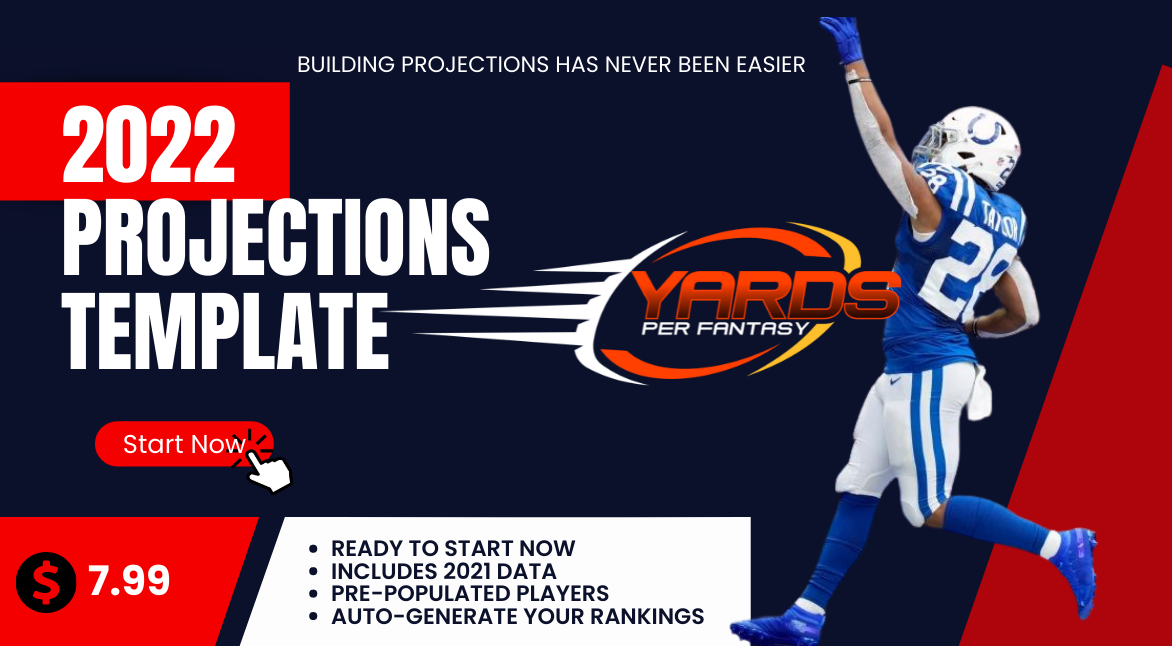 Draft With Us On Underdog! Use Promo-Code: YARDSPER for a 100% deposit match up to $100!
Draft With Us On Underdog! Use Promo-Code: YARDSPER for a 100% deposit match up to $100!
We spend hours and hours debating about which players are going to breakout, or which players are going to bust, or why this guy is overrated, or underrated, etc. While it’s certainly important to know who the good players are and who the not so good players are when preparing for our fantasy drafts, it’s just as important to be able to identify which players are in an environment that will allow them to maximize their skill set and, therefore, maximize their fantasy point potential. For example, when ranking wide receivers we usually consider who their quarterback is and how often the offense is projected to pass the ball. Afterall, volume is king right? The teams that pass the ball the most are obviously going to provide the best environment for wide receivers to reach their ceiling. It’s pretty much that simple for quarterbacks and tight ends as well. For running backs, we want an offense that is intent on running the ball early and often, right? Well…
Not so fast. Call me crazy, but in most cases I want my fantasy running backs to be in a similar environment as my fantasy wide receivers, quarterbacks, and tight ends. I know it sounds counterintuitive but hear me out.
Run-First Is Not Optimal…Even For Running Backs
In most cases, run-first offenses actually present a sub-optimal environment for running backs to maximize their fantasy scoring output. We said earlier that volume is king and that’s why we want heavy pass volume for our receivers and tight ends. And that’s certainly true. However, volume alone is not enough to reach a ceiling. Run-first offenses are gross. And sure, maybe a situation like the Ravens may be a bit different, but even then are we really thinking J.K. Dobbins is going to maximize his fantasy output in that offense? No. Why? Well, partly because he won’t have the opportunity to catch a lot of passes even though he profiles as a quality receiver. But more on that later.
Running the ball is less efficient than passing so, naturally these offenses are typically less efficient than those who choose to pass at a higher rate. They also play at a slower pace. Combine those together and now we have less opportunities because they’re less efficient (not converting first downs and extending drives) and are running fewer plays per minute (therefore, fewer plays per game/per season) and seeing fewer possessions. Remember, volume is king. But not only are they running fewer plays, but they aren’t finding the red zone as much because they’re less efficient and creating fewer possessions. Finally, fewer pass attempts, naturally means fewer targets for our running back. We know a target is worth 2.5x more than a carry so now we’re losing those fantasy points as well.
PROJECTIONS TEMPLATE – GET NOW!
Pass-First + Fast Pace = Great
Basically, you have to be Derrick Henry or Jonathan Taylor to be able to break through an offensive environment like that and still average 20+ fantasy points per game across the duration of a season. Otherwise, I want my fantasy running back to be in a pass-first offense that plays fast and has a good quarterback. This provides the opportunity to truly max-out their fantasy output. The numbers back this up, too.
In 2021, 60% of the teams that had a neutral game script pass ratio above league average finished in the top-half of the league in offensive efficiency. That’s providing a nice environment for all of our fantasy players, regardless of position. What about pace? 62.5% of the teams above league average in pace of play in 2021 finished in the top-half of the league in offensive efficiency. Pace of play plus pass-first, equals an even better environment. Nice.
Is This Really Beneficial To Running Backs, Though?
Yes, the numbers back this up, too. 54.2% of the running backs in the top-24 in PPR fantasy points per game (FPPG) in 2021 were on teams that had a neutral game script pass ratio above league average. That number was even better in 2020 at an incredible 67%. Half of the top-24 running backs came from teams who operated at an above average pace of play and 54.2% were on offenses that were top-half of the league in offensive efficiency.
We talked about maximizing the ceiling. How many of those running backs were RB1s? 67% of the running backs in the top-12 in FPPG in 2021 were on offenses that had an above league average neutral game script pass ratio. While that number was lower in 2020, it was still at an impressive 58%.
Bottom Line
While there are always exceptions to every trend, the outliers we see in this study are the other-worldly talents like Derrick Henry and Jonathan Taylor or a target machine like Alvin Kamara. The lesson here is that unless we’re drafting one of those rare breeds, we typically want a running back in an optimized offensive environment that passes a lot and plays at a fast pace. That’s going to give us:
- More efficiency
- More plays
- More touches
- More red zone trips
- More targets/receptions
- More fantasy points
- Higher ceiling
Which RBs Are In Offenses That Project To Fit This Mold In 2022?
- Leonard Fournette
- Ezekiel Elliott/Tony Pollard
- Devin Singletary/James Cook
- Clyde Edwards-Helaire
- James Conner
- Austin Ekeler
- Travis Etienne
- Cam Akers
- Dalvin Cook
- Najee Harris
- Saquon Barkley
- Jonathan Taylor*
*Colts were at league average in both pace and pass ratio in 2020 with Philip Rivers. Matt Ryan operated above league average in both categories with the Falcons.
Pass First Only:
- Joe Mixon
- Aaron Jones/AJ Dillon








